Data: beautiful and terrible

Data is everywhere. And it is beautiful. They are changing our lives , reinventing storytelling and having an impact on almost all industries - business, art, entertainment, music, technology.
Here are some vivid examples ...
Information Journalism

')
Totally terrifying infographics. The project, called “Out of sight, out of mind” , is the chronology of the drone drone strikes in Pakistan from July 2004 to December 2013.
Since 2004, the United States practiced a new kind of underground military operation. Using unmanned aerial vehicles to destroy enemy targets seemed attractive, since it eliminated the risk of losing the US military and was politically much easier to implement. The efficiency index was extremely low, and the losses among adult and child civilians were very high. The whole world could remain in ignorance of what is actually happening, and, as they say, out of sight, out of mind. This project helps to highlight the topic of unmanned aerial vehicles, not speaking for or against. After examining the data, you can decide for yourself whether you can support such use of unmanned aerial vehicles or not.
Visualization is created in HTML5 and JavaScript
drones.pitchinteractive.com
Talking about data visualization is not really complete without mentioning d3.js , an amazing javascript library that Mike Bostock , previously responsible for visualizing the data of the New York Times (following the collection of his works with code), created. Most of the data visualization projects that you see on the Internet today are built using d3.js.

For news publications, creating interactive stories can be tricky, but once seen, readers expect them more and more. Related Links:
Hans Rosling , who unfortunately passed away at the beginning of this year, in his famous lecture TED Talk presented data that debunked several myths about world development. It was unreal cool:
He also had his own BBC show, The Joy of Stats:
The time map of each nuclear explosion since 1945. Fearfully. Especially a lot of questions remain to the Soviet government, which conducted tests at different ranges strongly scattered throughout the country, in contrast, for example, to the United States. We recommend watching videos in accelerated playback mode.
Here is the final card:

More interesting examples with d3.js:
- Map of deaths from firearms in the United States: data.huffingtonpost.com/2013/03/gun-deaths
- Data Visualization from the 2012 NBA Finals: www.nytimes.com/interactive/2012/06/11/sports/basketball/nba-shot-analysis.html
- How many years you have left to live: flowingdata.com/2015/09/23/years-you-have-left-to-live-probably
- Day modes of famous creative people: podio.com/site/creative-routines
- Google Music Chronology: research.google.com/bigpicture/music
Quantitative self-determination
Nicholas Feltron, one of the leading designers of Facebook's timeline, has collected a lot of data about himself for many years, initially carefully describing his life on paper and then creating the application. As a result, these data were turned into annual reports. Read them here: feltron.com
More examples:
- ericboam.com/Seven-Months-of-Sleep-1
- ericboam.com/2014-A-Year-In-New-Music
- jehiah.cz/one-four
- Federico Zannier sold personal data for $ 2 a day . Using Kickstarter, he managed to earn $ 2,733. Federico offered to everyone the archive in which he collected: gps-tracking information, all the sites he visited, information about keystrokes, mouse movements, and even screenshots of his face every 30 seconds. www.kickstarter.com/projects/1461902402/a-bit-e-of-me/description
- Data coup helps you sell your personal data to datacoup.com
- Personal Information Cost Calculator: www.ft.com/cms/s/2/927ca86e-d29b-11e2-88ed-00144feab7de.html#axzz2z2agBB6R
GPS and tracking

Just Landed is a visualization of the tweets of people traveling around the world on an airplane. Jerome Thorp’s project looks for tweets containing the phrases “just landed ...” or “just arrived ...” and then visualizes the journey depending on the location at the time of the tweet and the person’s place of residence.
datavisualization.ch/showcases/just-landed-a-twitter-visualization-in-processing
More works by Jerome Thorp
- www.fastcodesign.com/1669702/explore-the-galaxy-using-the-actual-minority-report-interface
- intotheokavango.org
Micro-geolocation:

Tracking conference delegates via Wi-Fi and visualizing their movements and connections is a project that George Gully did several years ago. Wi-Fi can really be used to accurately determine the location of people.
radarboy.com/george/internetix.php
More GPS visualization:
- One day in the life of a taxi: nyctaxi.herokuapp.com
- Visualization of the Metropolitan Transportation Authority (New York):
Storytelling with visualization
Scale of the Universe: htwins.net
Simple but effective visualization of the length of time: hereistoday.com
Data visualization of the consequences of the division of Germany by the Berlin Wall: zeit.de/feature/german-unification-a-nation-divided
Data as art:

Dillon Marsh creates compositions for the visualization of production data in South African mines: www.dillonmarsh.com

Stephen Sagmeister's “Happy Show” - an exhibition whose goal is to measure and control the level of happiness: www.thisiscolossal.com/2013/08/the-happy-show-by-stefan-sagmeister
We hope you enjoyed this selection of visualizations. Do you know many more bright examples? share with everyone in the comments.
Source: https://habr.com/ru/post/334234/
All Articles